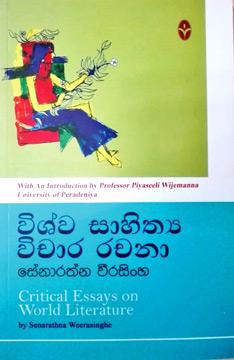
Vishva Sahithya Vichara Rachana
Author: Senaratne Weerasinghe
Prabha Publishers, Veyangoda
Pages: 148
Price Rs 400
Senaratne Weerasinghe’s latest book Vishva Sahithya Vichara Rachana (Critical Essays on World Literature) comes with an introduction by Prof. Piyaseeli Wijemanne of the University of Peradeniya. The book consists of 14 chapters covering different aspects of world literature.
Chapter I is devoted to a comprehensive discussion of D.H. Lawrence’s mysticism, Martin Wickremasinghe and Gamini Salgado. The author traces the development of Lawrence as a novelist and presents critical comments made about him by Martin Wickremasinghe. In Mysticism of Lawrence Martin Wickremasinghe held the view that Plumed Serpent depicted Lawrence’s mysticism. He said, The Plumed Serpent was Lawrence’s weakest novel. However, Prof. Gamini Salgado in his ‘Preface to Lawrence’ holds a different view. The author lays bare the facts for the reader to come to his own conclusions.
I found the chapter on novels quite interesting. Some people read novels, but others don’t. For instance, in the distant past we were not allowed to read novels by our parents and elders. They thought novels had a tendency to corrupt young minds. Instead, we were encouraged to read stories about heroes such as Dutugemunu or Veediya Bandara. However, Mark Twain and Ernest Hemingway drastically changed the scene. At the beginning Mark Twain wrote his biography which was full of humour and satire. Nearer home, Martin Wickremasinghe wrote his autobiography Upandasita and K. Jayatilaka wrote Punchi Pele Gasa Vena. They paved the way to generate an interest in readers to read novels.
The novel did not have its roots in the local soil. So we had to learn the art of writing novels from the West, mainly England and the United States. To understand the meaning of the novel, you should read Walter Allen’s The Tradition and Dream. According to him, novels originated in England and the United States are of the same quality because they were written in English. However, American novels had different characteristics not found in British novels. The chapter on the problem of studying characters in novels and criticism is quite interesting. Daniel Defoe’s Robinson Crusoe, published in 1719, had a hectic impact on the novel. Most of us have read it without knowing its literary influence on novel writing. Thereafter, authors took the trouble to have a hero or heroine in their novels. However, Marxist critics considered Robinson Crusoe depicted colonialism, capitalism and exploitation of countries.
Today, authors are at the mercy of book publishers. When a manuscript is given to a publisher the author does not know how many copies would be printed. As a result, he does not get his due royalties. Sometimes, publishers reject very good manuscripts because they do not know their value. Even Edward Fitzgerald’s translation of Rubaiyat was rejected by many publishers. However, after some time it became a best seller. Even Daniel Defoe could not find a publisher for his Robinson Crusoe.
Book publication is a big industry. According to a survey carried out in 1988, 75,000 new titles were published in Germany. The United Kingdom came close, publishing 62,000 titles in the same year. French publications exceeded 39,000 during the same period while the United States published 52,000 titles. Unfortunately, we do not know how many books were published in Sri Lanka as the figures are not readily available.
Whenever I visit my favourite communication centre, a girl working there always asks me whether I could give her some detective novels. They are the staple food of office workers and others who wish to while away the time. The author has narrated some episodes which are quite interesting and readable.
Literature has been divided into three segments: highbrow literature, popular literature and market literature. Highbrow literature is meant for the elite society. Popular literature includes love stories and detective stories.
The author’s views on magical realism enrich modern literature. As this is relatively a new literary concept, Sri Lankan authors in the past may not have been familiar with it. Today there is a greater awareness about magical realism among authors and readers. The author’s explanations and his writing style will appeal to the new generation of writers.
